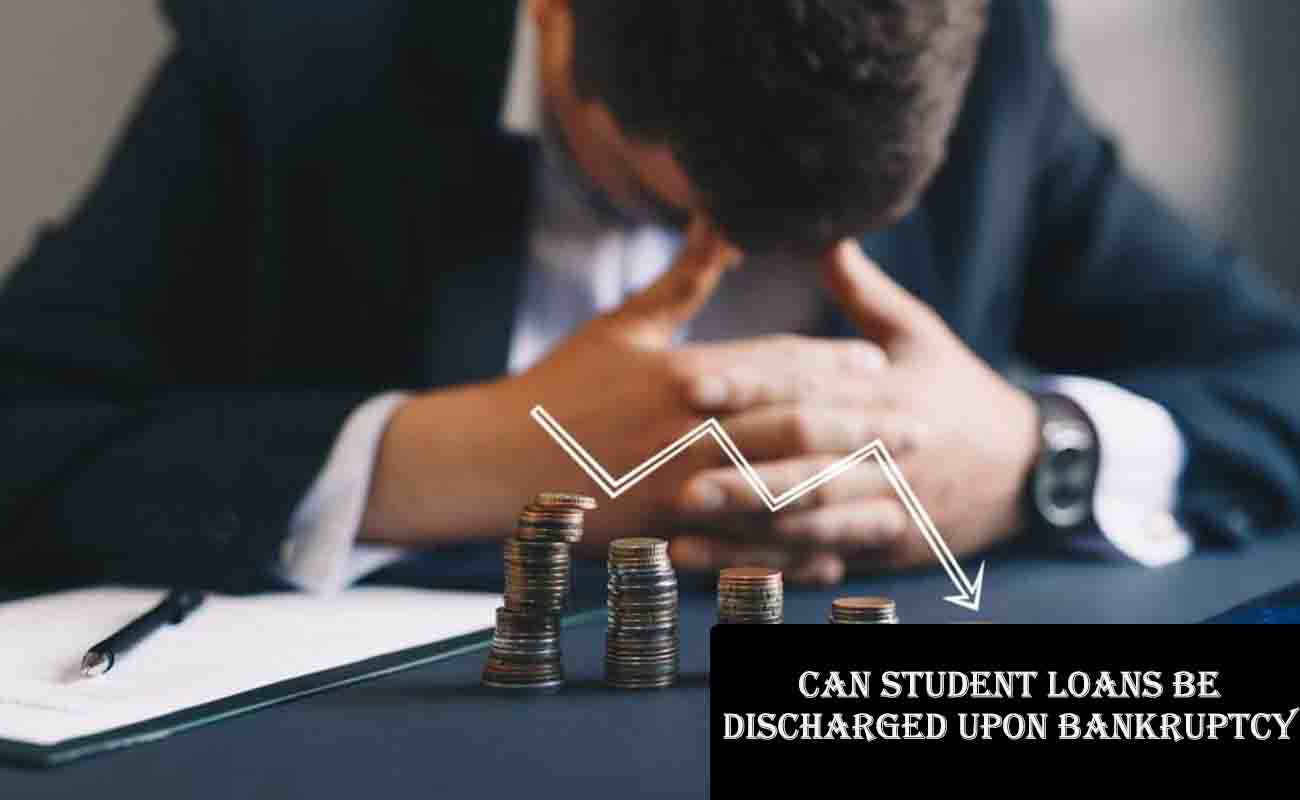Can Student Loans Be Discharged Upon Bankruptcy? I know student loans can feel like a heavy weight on your shoulders, and if you’re like me, you’ve probably wondered if there’s a way to escape them, especially when money is tight.

Well, I’m here to tell you that yes, it is possible to discharge student loans in bankruptcy, but it’s not as simple as wiping out other debts. In this article, I’ll walk you through the process, explain what it takes, and share some real-life examples to help you understand your options.
Whether you’re just curious or seriously considering this path, I’ve got you covered. Let me start with a quick story. A few years ago, I met someone who was drowning in over $100,000 of student loan debt. They were working multiple jobs, barely scraping by, and felt trapped.
Bankruptcy seemed like their only hope, but they’d heard it was nearly impossible to discharge student loans. Spoiler alert: it’s not impossible, but it’s not a walk in the park. That’s why I’m here to break it all down for you in simple terms.
Can Student Loans Be Discharged in Bankruptcy?
Let’s start with the basics. When we talk about discharging student loans in bankruptcy, we mean that the debt is forgiven, and you’re no longer legally required to pay it back. For most debts, like credit cards or medical bills, bankruptcy can clear them out fairly easily, but student loans are different.
They’re treated specially because they’re seen as an investment in your future, and the government (and private lenders) want to ensure they get paid back.
So, can student loans be discharged in bankruptcy? Yes, but you have to prove something called “undue hardship.” This is a legal standard that’s tough to meet, and it’s why discharging student loans has historically been so difficult. However, recent changes have made it a bit easier, especially for federal student loans.
What Is Undue Hardship?
Undue hardship is the key to getting your student loans discharged. You need to convince a bankruptcy court that repaying your loans would cause you and your dependents significant financial hardship. Most courts use a three-part test, known as the Brunner test, to decide this:
- Current Financial Distress: You must show that you can’t maintain a minimal standard of living (think necessities like food, housing, and transportation) if you have to repay your loans.
- Future Prospects: You need to prove that your financial struggles are likely to continue for a significant portion of the loan repayment period. For example, a disability or limited job prospects could help your case.
- Good Faith Effort: You have to demonstrate that you’ve tried to repay your loans in good faith, such as making payments when you could, applying for deferment or forbearance, or enrolling in income-driven repayment plans.
This test is strict, which is why only about 0.1% of bankruptcy filers succeeded in discharging their student loans before 2022. But don’t lose hope—things have changed, and I’ll explain how.
The New Process for Federal Student Loans
In November 2022, the Biden administration introduced a new process to make it easier for borrowers to discharge federal student loans in bankruptcy. This was a big step forward, and it’s helped a lot of people. Here’s how it works:
- The Attestation Form: You need to fill out a 15-page Attestation Form provided by the Department of Justice (DOJ) and the Department of Education (ED). This form asks for detailed information about your income, expenses, and any factors contributing to your financial hardship, like medical issues or unemployment.
- Presumptions of Hardship: The new guidelines include specific situations that make it easier to prove undue hardship. For example, you might qualify if:
- You’re over 65 years old.
- You have a disability that affects your ability to work.
- You’ve been unemployed for at least 5 of the last 10 years.
- You’ve been in repayment for over 10 years without reducing the principal balance.
- You didn’t complete the degree or program your loans were for.
- Impressive Success Rate: According to the DOJ, from November 2022 to March 2024, 98% of borrowers who used this form got at least a partial discharge of their federal student loans. That’s a huge leap from the past, when success was rare.
This new process is a game-changer for federal student loan borrowers, but it doesn’t apply to private loans. Let’s talk about the differences.
Federal vs. Private Student Loans
Not all student loans are created equal, and this matters a lot in bankruptcy.
- Federal Student Loans: These are loans from the government, like Direct Loans or Perkins Loans. The new process I just described applies to most federal loans, making it easier to seek a discharge. Plus, federal loans come with other relief options outside of bankruptcy, such as:
- Total and Permanent Disability Discharge: If you’re permanently disabled, your loans can be forgiven.
- Closed School Discharge: If your school closed while you were enrolled or soon after.
- False Certification Discharge: If your loans were certified for an ineligible program.
- Unpaid Refund Discharge: If your school owes you a refund but hasn’t paid it.
- Borrower Defense to Repayment: If your school misled you or broke the law.
You can learn more about these options at Federal Student Aid.
- Private Student Loans: These come from banks, credit unions, or other private lenders. Discharging private loans in bankruptcy is much harder because the new process doesn’t apply. You still need to prove undue hardship using the Brunner test, and there’s no streamlined form to help. However, some private loans might not be “qualified educational loans” (e.g., if they exceeded your school’s cost of attendance). These can sometimes be discharged without proving hardship. Check out this resource for more details.
If you have private loans, you might want to explore other options, like negotiating with your lender or consolidating your loans, before jumping to bankruptcy.
How to File for Student Loan Bankruptcy
If you’re thinking about bankruptcy to discharge your student loans, here’s a step-by-step guide to help you understand the process:
- File for Bankruptcy: You’ll need to file for either Chapter 7 or Chapter 13 bankruptcy.
- Chapter 7: This is for people with limited income and assets. It’s a liquidation bankruptcy, meaning some assets might be sold to pay creditors. It’s faster (4-6 months) but can be more disruptive. It stays on your credit report for 10 years.
- Chapter 13: This is for people with a steady income. You repay your debts over 3-5 years through a structured plan. It’s less disruptive but takes longer and stays on your credit report for 7 years.
- Initiate an Adversary Proceeding: Within your bankruptcy case, you must file an adversary proceeding specifically for your student loans. This is a separate lawsuit where you argue for the discharge. There’s no filing fee for this step, which is helpful.
- Complete the Attestation Form (for Federal Loans): If you have federal loans, you’ll need to fill out the Attestation Form from the DOJ. This form helps prove undue hardship and is key to the new process.
- Provide Evidence: You’ll need to submit detailed financial information, including income, expenses, assets, and any factors like medical bills or unemployment that show your hardship. Be thorough—this is critical.
- Court Review: The bankruptcy court will review your case and decide whether to grant the discharge. If the DOJ agrees to settle based on your Attestation Form, the process might be smoother.
- Expect Possible Opposition: Your student loan holder (especially for private loans) might fight the discharge. For federal loans, the Department of Education may agree to discharge if the cost of fighting exceeds one-third of the loan amount.
Here’s a quick table summarizing the key differences between Chapter 7 and Chapter 13:
| Aspect | Chapter 7 | Chapter 13 |
|---|---|---|
| Type | Liquidation | Repayment Plan |
| Duration | 4-6 months | 3-5 years |
| Eligibility | Limited income/assets | Steady income |
| Credit Report Impact | 10 years | 7 years |
| Best For | Those with little to no income | Those with regular income |
Real-Life Examples
To make this more relatable, let’s look at some real-life examples:
- Alista Lineburg’s Story: As reported by The New York Times, Alista Lineburg had $146,000 in federal student loan debt discharged using the new legal pathway. She acted as her attorney, which is rare but shows that determination can pay off.
- DOJ Success Data: The DOJ reported that 98% of borrowers who used the Attestation Form from November 2022 to March 2024 received at least a partial discharge. This highlights how effective the new process can be for federal loan borrowers.
These examples show that discharging student loans is possible, but it’s not a one-size-fits-all solution. It takes effort and the right circumstances.
Alternatives to Bankruptcy
Before you dive into bankruptcy, consider other options, especially for federal loans. Here are a few:
- Income-Driven Repayment Plans: These adjust your payments based on your income and family size. After 20-25 years, any remaining balance may be forgiven.
- Public Service Loan Forgiveness (PSLF): If you work in a qualifying public service job, your loans could be forgiven after 10 years of payments.
- Other Discharge Programs: As mentioned earlier, options like disability discharge or borrower defense might apply.
For private loans, you could try negotiating with your lender for a lower interest rate or a settlement. Consolidation or refinancing might also help, though these don’t forgive the debt.
FAQs
1. Can I discharge private student loans in bankruptcy?
Yes, but it’s much harder. You need to prove undue hardship, and there’s no streamlined process like for federal loans. Some private loans that aren’t “qualified educational loans” might be easier to discharge.
2. How long does the bankruptcy process take?
It depends on the case, but Chapter 7 typically takes 4-6 months, while Chapter 13 can take 3-5 years.
3. Will bankruptcy hurt my credit score?
Yes, bankruptcy will lower your credit score and stay on your credit report for 7-10 years, depending on the type of bankruptcy.
4. Are there alternatives to bankruptcy for student loan relief?
Yes, especially for federal loans. Options include income-driven repayment plans, PSLF, and discharge programs like disability or closed school discharge. For private loans, try negotiating with your lender.
5. Do I need a lawyer for student loan bankruptcy?
You can represent yourself, but a lawyer who specializes in bankruptcy and student loans can greatly improve your chances. The process is complex, and legal expertise helps.
Conclusion
So, can student loans be discharged in bankruptcy? Yes, but it requires proving undue hardship, which is a high standard. The good news is that the new process introduced in 2022 has made it much easier for federal student loan borrowers, with a 98% success rate for those using the Attestation Form. Private loans are tougher, but it’s not impossible.
Bankruptcy is a big decision with long-term consequences, like impacting your credit for years. Before going down this road, explore other options like income-driven repayment or forgiveness programs, especially for federal loans. Talk to a financial advisor or bankruptcy attorney to figure out what’s best for you. Everyone’s situation is different, but with the right information, you can take control of your financial future.
References
- Student Loan Borrowers Assistance – Bankruptcy
- Federal Student Aid – Bankruptcy
- Justice Department and Department of Education Announce Continuing Success of Student-Loan Bankruptcy Discharge Process
- How to File for Student Loan Bankruptcy
- Discharging Student Debt in Bankruptcy Is Supposed to Be Easier Than Before
- New Process to Discharge Student Loans in Bankruptcy
- Busting Myths About Bankruptcy and Private Student Loans
- Can Private Student Loans Be Discharged In Bankruptcy?
- Student Loan Discharges Approved In Most Cases Under New Bankruptcy Policy
